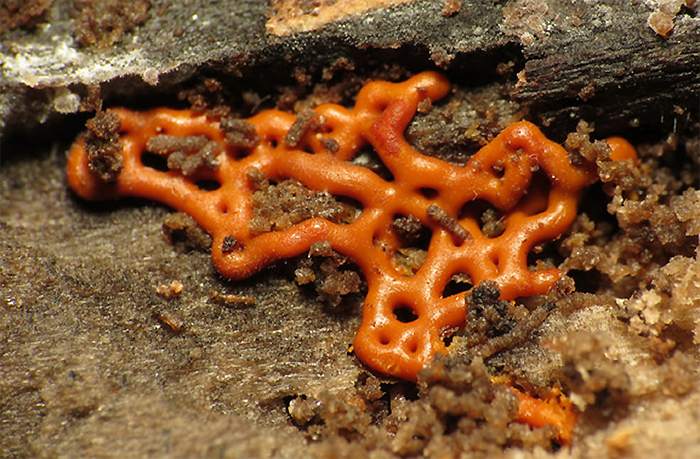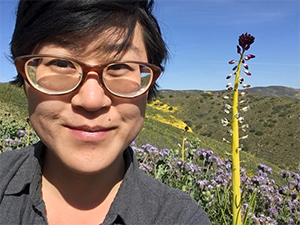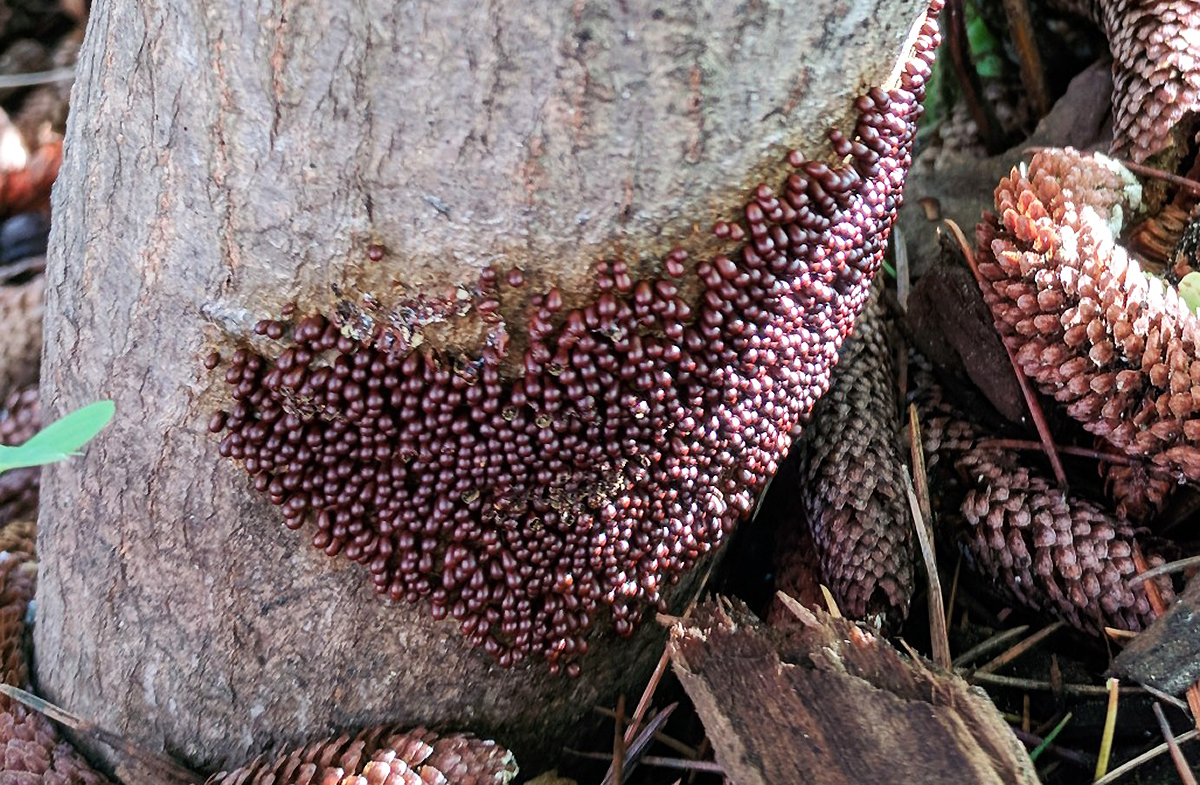Any thoughts on what these mysterious tiny “eggs” (pictured above) may be. Insect? Fungal? Galls? Found at the base of a newly planted maple tree in Oakland. Thanks. – Marcie Kramer, Oakland
These certainly do look like insect eggs, but if you cracked one of them open, you would actually find a mass of spores instead of developing larvae, because these are the fruiting bodies of a slime mold! This species is commonly known as insect egg slime mold (Leocarpus fragilis), for obvious reasons.
So, what are slime molds? These organisms generally feed on bacteria and are frequently found on decaying bark, leaf litter, or living tree bark, as in this case.
Because they often look like fungus and share a similar habitat, slime molds were history classified as fungi, but today they are considered amoebozoans, a large group of eukaryotic single-celled organisms. But take that classification with a grain of salt, as our understanding this group seems to be ever shifting.
Slime molds evolved around 700 million to 1 billion years ago and have an incredible life cycle, transforming radically from a mobile, feeding phase to a static reproductive phase.
They reproduce by spores, which germinate into (usually) haploid cells. When two compatible haploid cells meet, they fuse into a diploid zygote. This nucleus of the zygote begins to divide repeatedly, creating a sort of megacell, a blob of protoplasm with thousands of nuclei.

This blob, which is called a plasmodium, fans out looking for food in a slow pulsating movement called cytoplasmic streaming. The plasmodium of the many-headed slime mold (Physarum polycephalum) has been used for solving mazes and even mapping the Tokyo transit system in its quest for food.
Plasmodia are usually clear, white, yellow, orange, or red, and can grow large enough to be visible to the naked eye. Touching a slime mold in this stage feels like touching snot and will leave a slimy residue on your finger. Unlike a jelly fungus, a slime mold plasmodium is not firm and won’t retain its shape when poked.
Eventually, the plasmodium creeps into a drier spot and develops into one or more fruiting bodies, ephemeral structures containing tons of spores, which eventually disperse to restart the life cycle.
There are fewer than 1,000 species of plasmodial slime molds known worldwide. (Plasmodial slime molds are in the class Myxomycetes, not to be confused with cellular slime molds or protostelids, which cannot be seen without a microscope). Most species are cosmopolitan and tend to be common in temperate zones.
While hiking in the Bay Area, you might occasionally spot dog vomit slime mold (Fuligo septica), red raspberry slime mold (Tubifera ferruginosa), or wolf’s milk (Lycogala epidendrum). These species tend to catch observant eyes because of their larger fruiting bodies and brightly colored plasmodia.
But if you have the patience to stop and scrutinize a decaying log for a couple of minutes, you may be rewarded with the sight of even smaller slime molds, which are often only a few millimeters tall but no less impressive. Slime mold fruiting bodies take on a dazzling diversity of shapes and colors, and it’s easy to get lost in this world of iridescent orbs, fuzzy billowing columns, maze-like squiggles, and intricate lampshades.

Though easily overlooked by humans, slime molds consume bacteria and provide food for ants, slugs, snails, and other organisms. There are even beetles that feed exclusively on slime molds.
If you become obsessed with slime molds and want to see more (and who wouldn’t?), hit the trails shortly after a rainy day with a good hand lens. In cool, damp, shady places, check decaying stumps or logs that have lost some, but not all, of their bark.

There are also some resources to help you dive into the world of slime molds. A great place to start is Myxomycetes: A Handbook of Slime Molds, written by Dr. Steven L. Stephenson, a professor at the University of Arkansas.
Though dated, The Myxomycetes, by G. W. Martin and C. J. Alexopolous, is considered the bible of myxomycetes, with dichotomous keys and detailed color plates. The book is out of print, but luckily the color plates are all available online.
 Angela Pai is a naturalist with the California Center for Natural History.
Angela Pai is a naturalist with the California Center for Natural History.
Ask the Naturalist is a reader-funded bimonthly column with the California Center for Natural History that answers your questions about the natural world of the San Francisco Bay Area. Have a question for the naturalist? Fill out our question form or email us at atn at baynature.org!


